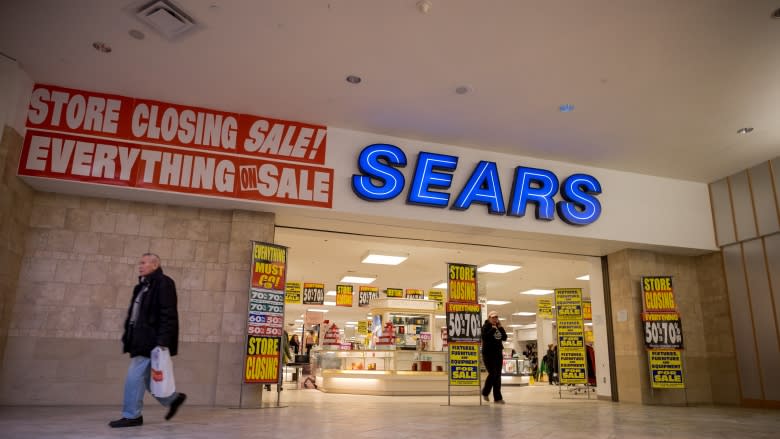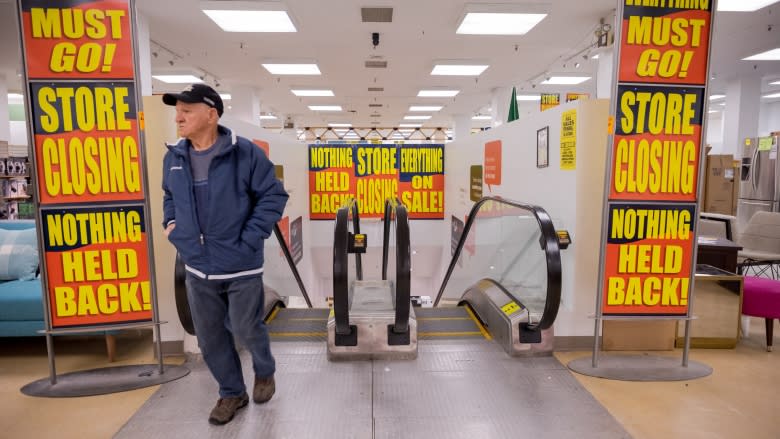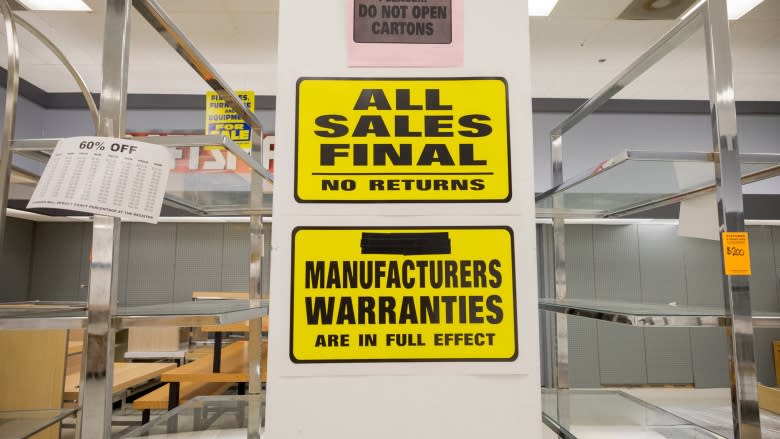Final Sears Canada stores shuttered for good
All remaining Sears Canada stores will close their doors for good on Sunday, including 17 in Ontario.
The department store chain had been in business in Canada since 1953, but struggled in recent years to adapt to the internet age and a changing retail environment.
That left the retailer little choice but to announce late last year that it would shutter all of its remaining stores after a last-ditch effort to re-invent itself as "Sears 2.0."
The chain spent the bulk of its last year in existence attempting to change itself — a hodgepodge process that included adding grocery stores to certain locations, hosting a pop-up shop in a trendy Toronto neighbourhood and developing dash buttons that would give customers the ability to restock favourite products from home.
But those efforts failed to boost sales and the long-time staple of Canada's retail landscape filed for creditor protection in June, sold off some locations and decided to liquidate the rest of its roughly 190 stores, leaving some 12,000 employees out of work.
"It's the end of era," said shopper Shane Hakim outside the store's Pickering location on Sunday. "It's kind of sad in a way, to see it from what it was to what it is now," he explained, adding how odd it is to see the sprawling store nearly empty.
"When I was a kid, especially, we used to get the catalogue and see all the things we wanted for Christmas ... It was a lot of fun. I guess it brings back a lot of memories."
Many mistakes made: expert
The chain's demise is the end of an era, retail expert John Williams tells CBC Toronto, but also a sign that remaining department stores can't afford to make mistakes.
Sears Canada failed because it focused too much on real estate, he says, and adds it didn't change with the times, failed to stand out and ultimately became mundane.
Its biggest mistake, Williams says, was not taking advantage of its very popular print catalogue.
"Sears had every opportunity, with its catalogue, to jump into the e-commerce world, and they flubbed it," he said.
Williams adds that Sears Canada did many things right, however, such as having popular brands, including Kenmore, as well as good merchandise and sales people, but the chain didn't pull it all together.
It then declined as Walmart grew and Hudson's Bay revitalized itself.
Competition remains for other department stores
Now, Williams says remaining department stores must compete with Amazon or follow the path of Sears.
"The really, really interesting thing about the retail industry is the 900-pound gorilla — Amazon — followed by another gorilla, Alibaba, out of China," he added. "They're there. You can't see them, but they're there. And they are gobbling up market share at a horrific rate."
A report by J.C. Williams Group says about 30 per cent of Canadians are members of Amazon Prime, a paid membership that means free two-day shipping.
The importance of online options was not lost on Jane Mana, who went to Sears' Pickering store to take advantage of the last-minute liquidation deals. She told CBC Toronto that she used to purchase most of her furniture and home appliances from the retailer, while her husband appreciated the store's collection of quality business suits "at a good price.
"We're going to miss all that now," she said. "It's different now, though. We have to get used to the online stuff now. It's part of the future."
As for the malls that now have a Sears-sized hole to fill, Williams says they could do without another department store.
"The brutal truth of it is, in Canadian retailing, there is just so much of everything. We are awash in everything we ever need," he said. "No mall needs another dress store, no mall needs another shoe store, no mall needs another Sears. They are not going to miss them."
'Too little, too late'
Retail analysts found many problems with how Sears approached the market, particularly in recent years. Barry Nabatian says the department store's closure is a reminder that the company didn't adapt quickly enough to the shifting retail landscape.
The analyst said Sears had a business model that was outdated, and while they made changes toward the end to reach younger customers, it was "too little, too late."
"It was really the kind of department store your parents would shop at, not young people," he said, adding that people are looking for a different experience now, at "stores that are more dynamic, more attractive and have more of an 'oomph' to them."
Sears' final days
Sears faced a number of controversies in its last days, including when it planned to dole out millions of dollars in retention bonuses to head office staff while grappling with a more than $260-million shortfall in its pension plan.
A plan by executive chairman Brandon Stranzl that would see the company continue to operate was rebuffed in favour of liquidation, prompting further questions about whose interests were being prioritized.
After the sales began, the Competition Bureau said it was investigating allegations that some merchandise was marked up ahead of the liquidation.
Still, Sears will be remembered by those who grew up devouring its annual holiday wish book and visiting its store in better days.
News of the closure was named the 2017 Business News Story of the Year in an annual poll of the country's newsrooms conducted by The Canadian Press.
"For many Canadians, Sears is more than a store, it's an institution," Allan Shifman, managing editor at Yahoo Canada Finance, told The Canadian Press.
"Add to that the horrible way the retailer wound down... This is a story that resonates with all Canadians, not just the ones tuned into the finance news cycle."







